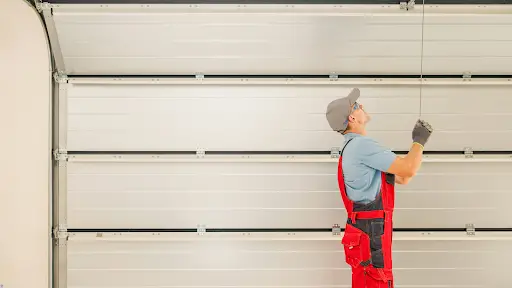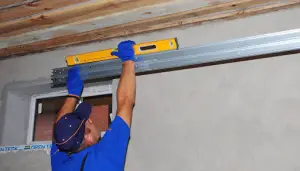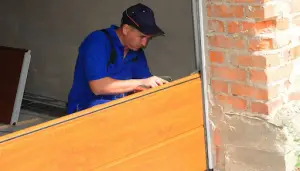Having a secure and accessible home lies in maintaining a functional garage door. However, not all repairs require professional help. Little expertise and correct tools applied to prevalent problems can solve most garage door issues. 10 Simple Steps to Fix Your Garage Door provides an easy guide to these challenges.
You can confront them step by step, starting with identification, collection of required implements, adjustments, and testing for safety, among other things, within the quickest time possible. These steps are simple; there’s no reason why you shouldn’t be able to carry out repairs confidently, saving your time and money while keeping the quality of your garage door at its best.
- Release the tension
For safety purposes, when dealing with torsion springs, loosen the screws which hold the track against the frame allowing for slight adjustments. A rubber mallet helps to realign it properly without causing any damage by tapping it gently on the track. The torsion tube should then be secured, and two winding bars should be used to be safe when doing any repairs.
Based on recommendations from garage door repair Calgary experts, this step must be taken before carrying out any further repair works or new part installations. Failing to adjust these items properly may lead to much pressure being maintained within the system, making other future maintenance activities difficult on your door.
- Install new panels and tracks
Start by aligning correctly positioned tracks at equal heights along both sides of garage walls before installing new panels and tracks on a garage door. They must be leveled well in order not only for them to function smoothly but also so as not to create other problems later. Tighten all loose mounting brackets, attaching tracks onto walls. Additionally, those bringing new panels up should know that many different online manuals exist to guide them step by step through this process, making it suitable even for first-timers.
- Replace parts and lubricate
Once the new panel has been put up and the track installed, they should also replace any damaged pieces while carrying out this procedure; it would be good if they could also lubricate various joints such as rollers, hinges, and weather stripping, among others. For smooth running, some of these parts must be replaced, especially worn or rusted parts. However, you may choose either to oil them or remove them completely. If you want your gate to serve you long, grease all metallic components regularly.
- Check for sensor blockages
These blockages can stem from various causes, including dirty lenses, misalignment issues, or faulty electrical wiring connections. Addressing these problems promptly is essential to ensure smooth and safe garage door functionality. Dirty lenses on the sensors can hinder their ability to detect objects accurately, potentially leading to malfunctions. A simple solution is gently cleaning the lenses using a soft, dry cloth or a mild cleaning solution.
- Address spring and roller issues
Rusty or old rollers can slow the performance of a garage door. They should be lubricated using silicon or white lithium grease. This will make them move better and reduce noise. If the rollers are too bad to be repaired, they must be replaced so that the door operates smoothly. Expert intervention is necessary if there are broken springs because it can be risky. When the rollers are damaged or if there are spaces between them and their rails, there would be operational challenges. Proper alignment of these parts will enable the gate to work safely and efficiently.
- Replace the opener and remote batteries
Firstly, uncover either your control unit or transmitter to access the old battery cells. After that, insert new ones according to the polarity indicated inside the compartment. Reprogramming might be necessary after replacing the power sources to ensure everything works smoothly again. It is important to keep transmitters and receivers powered up so they do not stop working when the garage door is used.
- Fix unusual noises and alignment
To eliminate these sounds and align the entrance correctly, all nuts and bolts should be tightened. This will prevent anything from shaking loose during its operation. Examining the tracks for any signs of being out of place or worn can also help deal with noise and jerky movements. Loose items like hinges may be tightened while straightening bent tracks must be done instantly so as not let them make the gate operate noisily and inefficiently for long.
- Clean and lubricate for slow opening
The solution for slow garage door opening is cleaning and lubricating its movable components. Hinges, rollers, springs and tracks should be applied with lithium grease or any other lube specifically made for use in this area. WD 40 or oil is not recommended as it will not last long before drying up, thus making it necessary to repeat the whole process frequently.
Regular cleaning also helps to maintain a smooth operation of the gate therefore homeowners need to ensure that they do so. Doors may open faster and serve longer once necessary parts are oiled or greased.
- Check transmitter and keypad syncing
Initially, the batteries in both devices should be eliminated and replaced to make sure they are functional. Next, inspect the keypad for any frayed wiring that might be causing a problem. If the opener still works with a push of a button, you may need to sync it with the remote. Press the “Learn” button on the opener for syncing until the indicator light starts flashing. This signifies that it is ready to receive programming from either a remote control or a keypad.
- Seek professional help if needed
Trying to fix your garage door by yourself can sometimes create more harm than good. This is why seeking professional help remains the safest bet in ensuring safety and reliability. Technicians possess appropriate tools and knowledge when faced with complicated situations such as track replacements or opener/remote malfunctions. Calling for a repair service for those fixes beyond your capabilities will save time and prevent possible injuries. Whether loose screws cause trouble or moving components need inspection, skilled hands should handle such tasks for quick solutions.
To conclude
If you take on garage door repairs alone, you can save time and money. These 10 simple steps will ensure the door works again without needing help. Homeowners deal with most problems quickly, from releasing tension to syncing devices.
Regular maintenance and timely fixes will prevent later problems, making garage doors operate smoothly for years. The satisfaction of doing it yourself brings joy while maintaining home upkeep.


















